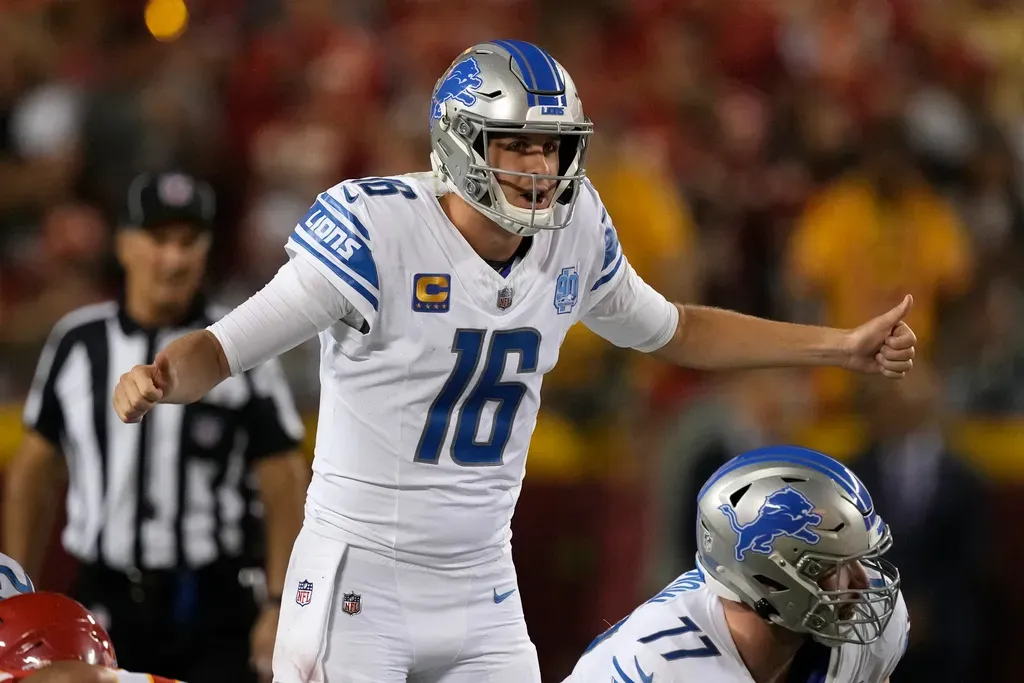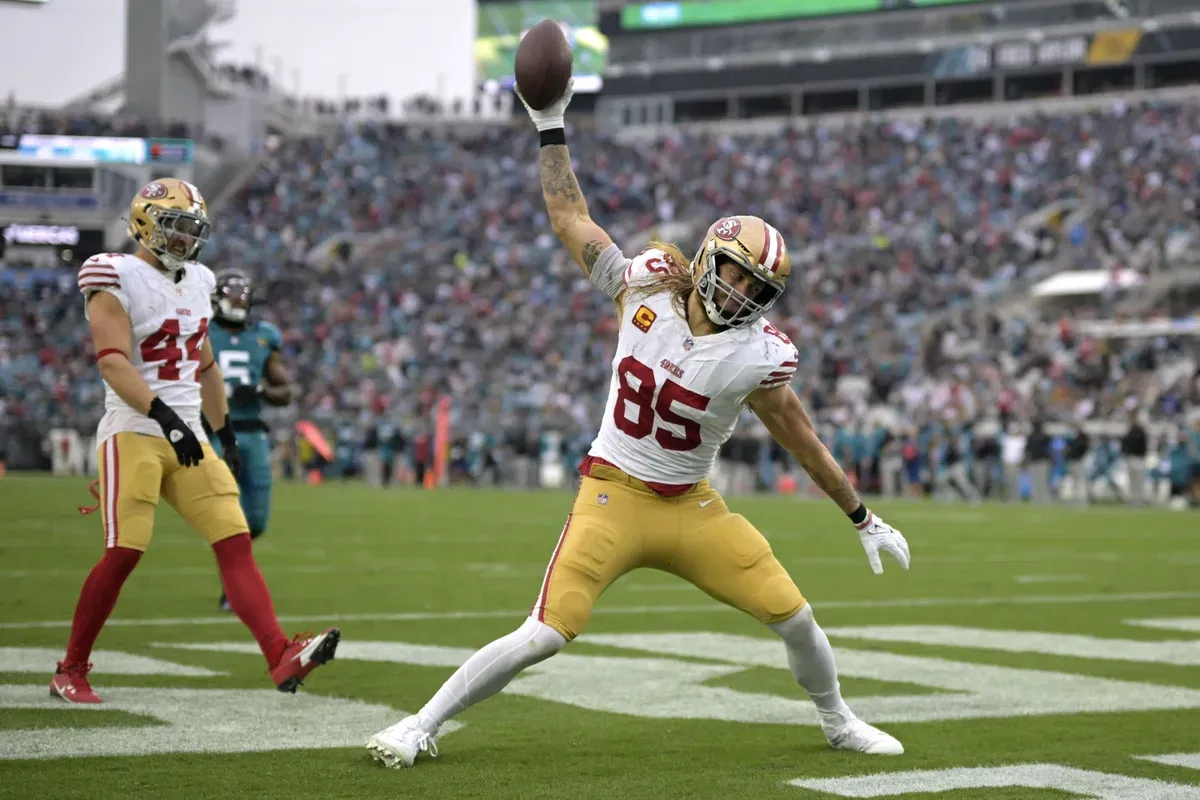
Week 7 Walkthrough: Jared Goff Rises in the East
Welcome to the Week 7 Walkthrough.
In this article, I'll outline critical fantasy football context for this seventh glorious week of football.
(The stats below are from PFF, NFLfastR, rbsdm.com, RotoViz, FantasyLabs, ESPN, NFL Next Gen, and Fantasy Life).
Splash Zone Target Rate
While in a full sprint to preview 12-16 games every week, it can be hard to find the time to stop and explain why I’m looking at the data I’m looking at. I dove into some thoughts on the first-read target data in the Week 2 Walkthrough, and I wanted to do the same this week on a different type of target.
Last week, I started discussing “downfield-middle targets”. These are targets that travel 10+ air yards and are delivered to the middle of the field.
Why do we care about these targets?
Because they tend to lead to more fantasy points than other types of targets.
In 2019, Hayden Winks dove into the importance of these targets, highlighting the importance that target location relative to the sideline has on PPR scoring.
“Where a receiver is catching the ball in relation to the sideline is very important and might be the most underrated aspect of evaluating receivers right now.”
At that time, we fantasy obsessives were obsessed with air yards—the more air yards, the better. But Hayden noted that the idea of “prayer yards” – incomplete air yards that aren’t worth as much as they look like on paper – applies to more than just QB accuracy and micro ball placement. It also matters whether targets are occurring in the middle of the field or along the sideline.

Hayden notes that Curtis Samuel, who has ironically shifted to more of a middle of the field role, was the king of misleading target volume in 2019.
"Samuel’s air yard totals were phony for reasons beyond Kyle Allen‘s inability to throw deep passes. 92% of Samuel’s targets and 88% of his air yards came on the less-valuable outside targets. That, simply put, is not good for fantasy."
I spent some time writing about this target type last season—with the Dolphins building their offense around attacking the middle of the field, it was hard not to. But I’ve struggled to communicate efficiently on the subject. “Downfield-middle targets per route” is a bit spreadsheet-brained even for me.
So in the interest of discussing the data more simply, I’ll be referring to these as splash zone targets.
After all, the point of looking at these targets is to find players who are being set up for deep catches and elite YAC gains, hopefully for house calls... you know, splash plays.
And at ~10 yards deep, over-the-middle targets average 2.0 PPR points. Sideline targets don’t hit that mark until ~28 yards downfield.
We definitely would like to know who will see a high rate of splash zone targets moving forward. But that can be hard to determine because the sample sizes on splash zone targets tend to be pretty small.
Tyreek Hill and Adam Thielen [gulp] lead the NFL in splash zone targets. But they’ve totaled just 14 in six games. That’s why I waited until we had five weeks of data before adding them to this analysis. But even now, this is a tool for helping us marginally improve our understanding of how valuable a receiver’s role is. It’s not the type of thing to put a ton of stock in on its own.
In the previews below, I’ll generally be referring to splash zone targets per route or "splash zone target rate." But if you’re curious, here are the top 36 pass catchers in splash zone targets per game (min. 100 routes).

Quick Links:
- Lions at Ravens, 1PM
- Bills at Patriots, 1 PM
- Raiders at Bears, 1 PM
- Browns at Colts, 1 PM
- Falcons at Buccaneers, 1 PM
- Commanders at Giants, 1 PM
- Steelers at Rams, 4:05 PM
- Cardinals at Seahawks, 4:05 PM
- Packers at Broncos, 4:25 PM
- Chargers at Chiefs, 4:25 PM
- Dolphins at Eagles, 8:20 PM
- 49ers at Vikings, 8:15 PM, Monday
Lions at Ravens, 1 PM
Lions Implied Team Total: 19.5
Jared Goff has been outstanding this season, ranking QB6 in EPA per game and QB8 in success rate. He hasn’t been elite, but still profiles as one of the top QBs in the league.

The Lions also showed a lot of faith in Goff last week. Heading into their matchup with the Buccaneers, they looked like a strong bet to control the game by pounding the rock. But with David Montgomery exiting with a rib cartilage injury, they still controlled the matchup… but with the passing game.

With David Montgomery expected to miss Week 7, the Lions will need to lean on Goff once again. But Goff will be facing a much more difficult Ravens defense that ranks fourth in EPA allowed per dropback and third in dropback success rate.

But Goff actually looks like a good fit for this difficult matchup. The Ravens blitz frequently, but Goff is used to facing the blitz and has held up decently well against it. Goff has also been highly consistent and should be able to handle the Ravens' excellent secondary fairly well.
Goff's can make mistakes under pressure, but the Lions' offensive line looks capable of holding up against an above-average Ravens pass rush. With the game plan falling on his shoulders, Goff should deliver.
And although the Ravens are allowing explosive plays at the league’s lowest rate, they’ll need to be on guard against an offense that is ramping up Jameson Williams.
Williams only ran a route on 19% of dropbacks against the Buccaneers, down from 50% against the Panthers. He’s a very risky fantasy play because he won’t be on the field a ton. But when he’s running routes, he creates serious big play risk for the Ravens' defense. His fantasy impact will be tough to count on, but he should have a real-life impact on this matchup. Williams saw three targets against the Buccaneers with an average depth of 23.3 yards. All three were first-read looks—meaning the Lions were dialing up deep shots for him despite his limited snaps.
Williams’ role should help open things up underneath for Amon-Ra St. Brown and Sam LaPorta. Both St. Brown (14) and LaPorta (11) feasted on targets against the Buccaneers, and we could see a similar dynamic this week.
Even on limited passing volume, St. Brown looks like a WR1. He’s seeing an elite 22% first-read target rate and 27% TPRR. He’s going to get his targets. And despite a shallow 7.7 aDOT, St. Brown is seeing a lot of valuable over-the-middle opportunities. The third-year star ranks 85th percentile in splash zone targets per route.

Sam LaPorta’s opportunity looks less locked in. He’s earning an elite 25% TPRR but with a good-not-great 15% first-read target rate. If Goff has time to work through his progressions, LaPorta should see plenty of targets again this week. But if the Ravens disrupt things with their solid pass rush and willingness to blitz, LaPorta’s target rate could overstate his involvement in this outing. However, given the state of tight end, it’s hard to imagine you have a better option than the star rookie.

In the backfield, things look very murky, with both Jahmyr Gibbs (hamstring) and Craig Reynold (hamstring, toe) limited in practice.
One thing I feel confident saying is that even if Gibbs goes, he's likely to play alongside an early-down complement. The rookie has been an impressive receiver but isn't flashing as a rusher. And the Lions don't appear to view him as an early down weapon at this stage. Still, if he suits up, Gibbs profiles as solid RB2. The Lions building their attack around the pass would actually be great news for the receiving weapon.

Ravens Implied Team Total: 22.5
The Ravens might be more willing to pass this season, but they certainly haven’t been a pass-first team so far. With a -2% PROE, they qualify as a run-first offense.
The Ravens have found themselves in a fair amount of neutral and positive game script, however. They’ve kept things pretty conservative, but they aren’t fighting game script to do so. Their expected pass rate is just 59% (26th) and they've topped 60% just once.

By comparison, the Falcons’ expected pass rate is 68% (fourth) and they’ve topped 60% in every game this season.

Because the Falcons are consistently fighting these scripts, we can feel confident that they will seek to limit passing volume whenever possible. But for now, all we can confidently say about the Ravens is that they will dictate the run when playing in competitive games.

But Baltimore's defense is up against an impressive Lions offense that has a realistic shot of putting up points against them.
And Baltimore’s offense is up against a Lions defense that has been impressive against the run and is profiling as a pass funnel. Teams are averaging a 5% PROE against the Lions and are shifting 4% to the pass. In combination with a Lions offense that could be more pass heavy without David Montgomery, we could see the Ravens take to the air.

The Ravens should also be willing to test a Lions pass rush that ranks just 27th in pass rush win rate and 28th in quick pressure rate. Lamar Jackson has been consistent this season, ranking QB4 in success rate. What he needs are more big plays; he ranks just QB17 in EPA per game. This matchup could help him get there. The Lions rank just 21st preventing 15+ yard pass plays.

Unfortunately, the Ravens’ WR corps has devolved into a rotation. Nelson Agholor saw 62% route participation against the Titans, with Rashod Bateman at 51%, and Odell Beckham at 43%. And this is in line with the season-long rates.

This leaves Zay Flowers as the Ravens’ only fantasy viable WR. But Flowers looks pretty interesting in a matchup that could push passing volume up a notch. He’s earning a strong 23% TPRR with a high-end 28% target share. His first-read target rate doesn’t pop, but that’s partly because of his usage in the screen game. Flowers has seen 28% of his targets on screens, which PFF doesn’t typically chart as first-read targets. But in conjuction with a healthy mix of traditional targets, Flowers’ screen usage looks like a boost to his PPR profile. He looks like a WR2 here.

Mark Andrews also looks very interesting this week. Andrews has a fairly similar profile to Zay Flowers, although the tight end actually has the deeper aDOT. If the Ravens are attacking downfield more aggressively this week, Andrews should be a big part of that game plan. The tight end has been somewhat disappointing this year but remains an elite option.

Even if the Ravens are able to execute their typical, run-first game plan, the backfield doesn’t look very interesting. Gus Edwards is coming off a 61% snap share against the Titans and should handle the bulk of the work if the Ravens are in a competitive script.

But Edwards hasn’t been very efficient this season and is going against a difficult Lions defense. He’s a TD-or-bust bet.

But even if this game becomes up-tempo, Justice Hill isn’t likely to turn in a big game. He’s more involved as a receiver but averages a horrendous 0.44 YPRR. It’s a stretch to call him a receiving back. He’s a dart throw fill-in.

Bills at Patriots, 1 PM
Bills Implied Team Total: 24.25
The Bills are coming off an uninspiring 14-9 win over the Giants. And Josh Allen was disappointingly mediocre against a weak Giants defense.

But when looking at the season as a whole, Allen still looks like a strong bet (the strongest bet on the board in my opinion) for MVP.

With a firmly pass-first 3% PROE, the Bills have built their offense around Allen. And the Bills have been pass-first from a position of strength. They have the same expected pass rate as the Browns, but are calling plays very differently.

The Bills can be expected to control this game, and the Patriots’ defense doesn’t give them any reason to shift from their typical playcalling approach. The Patriots have been solid across the board against the run.

The Bills have an efficient run game, but unfortunately for fantasy managers, carries have been split. James Cook is coming off his second-highest carry share of the season… at just 52%. And Cook doesn’t lead the backfield in inside-the-5 attempts; Latavius Murray does.

Cook is the lead back in a committee, rather than a true starter. But at least he’s flashing high-end talent. Cook ranks RB8 in RYOE per game and RB3 in success rate. He’s also playing well as a receiver, ranking RB13 in YPRR. The Bills may not fully trust him yet, but their trust will build if he keeps playing like this.

But in this matchup, the running game sets up as a secondary mode of attack. Josh Allen will lead the charge.
The Bills’ elite QB is going up against a Patriots defense that isn’t getting to the passer and is also vulnerable on the backend, ranking 23rd in PFF’s coverage grades.

Assuming Dalton Kincaid returns from his concussion he should slot back in as the Bills' third WR. Oh, are we still pretending Kincaid isn’t just a mislabeled WR? Why? That’s exactly how defenses are treating him.

And if we are to view Kincaid as the Bills No. 3 WR, it’s not a very flattering picture.

After Week 1, I quickly admitted that Kincaid’s path to playing time was a lot simpler than I anticipated. I didn’t expect the Bills to literally treat him as a WR. But I also noted that Kincaid still needed to prove he was actually an NFL playmaker. Unfortunately, we’re still waiting on that.
Kincaid’s 14% TPRR and 0.89 YPRR are poor for any position, but they are especially weak for a WR. Of course, we have the luxury of putting Kincaid into fantasy lineups as a TE.
But for real-life purposes, if you aren’t helping shift defensive coverages and aren't contributing receiving production… what would you say you do here?
Of course, even when compared to WRs, Kincaid looks more efficient than Dawson Knox.

So the real question isn’t – why are the Bills playing Dalton Kincaid? – it’s why are they insisting on playing Kincaid and Knox together. Again, defenses aren’t respecting these looks as true 2TE sets. So the Bills may as well try to get Knox off the field for as many receiving snaps as possible, which would allow them to play a de facto 4WR set with Kincaid.
But as is, only Stefon Diggs jumps out as a high-end option. We breezed right by Diggs’ profile. But he’s been absolutely elite this season. And it can’t hurt to compete with targets for three players who have a 16% TPRR or lower.
Although Gabe Davis is struggling to earn targets, as usual, his 15.5 aDOT gives him big-play upside every week. He’s a solid FLEX play as a bet on the Bills offense.
Patriots Implied Team Total: 15.75
Mac Jones played poorly against the Raiders. He also played significantly better than he had over the previous two weeks. That’s the kind of season Jones is having.

Jones ranks QB30 in EPA per game, ahead of only Bryce Young, Zach Wilson, and Daniel Jones. His consistency hasn’t been quite as bad, but he still ranks just QB26 in success rate.

Jones now faces a Bills defense that is allowing explosive passing plays but has otherwise been very sound.
Even after suffering several major injuries over the last few weeks, the Bills weren't bad against the pass in Week 6.

With the Bills likely to play from ahead this week, we should at least get some passing volume from the Patriots. With a -4% PROE, the Patriots are definitely trying to limit passing attempts. But they aren’t completely fighting game script either. Their 64% pass rate is the 13th-highest in the league.

Normally, even passing volume doesn’t do much for the Patriots. Their receiver landscape is that bleak. But in the charred landscape of the New England offense, Kendrick Bourne is the lone green shoot.

And the Patriots are finally showing the good sense to play Bourne in a full time role.

He has logged 90% route participation in back-to-back weeks and profiles as an intriguing DFS play / dart throw FLEX.

If Hunter Henry misses this game, Mike Gesicki also looks like a viable DFS play. Gesicki’s 9.3 aDOT is leading to a surprisingly valuable per-route role that bears a striking resemblance to Hunter Henry’s.



